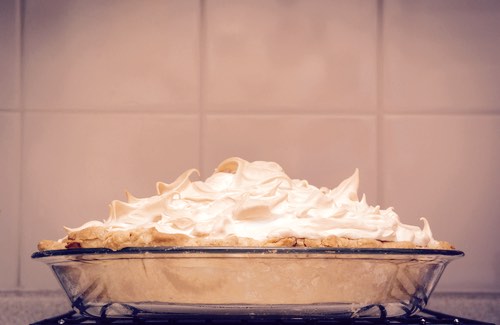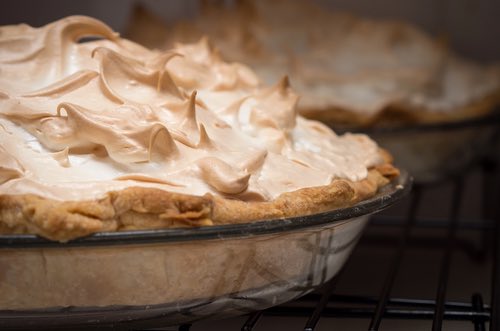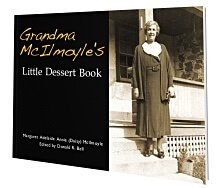- Home
- Pies and Tarts
- How to Make Meringue Topping
How to Make Meringue Topping
Learning how to make meringue topping for pie is easy when you follow Grandma's proven old fashioned methods.
No more shrinking away from the pie crust or weeping for your meringues! Simply follow the easy directions and helpful tips below to always get perfect results.
How to Make Meringue Topping for Pie
Mom's Recipe Scrapbooks (c.1920s)
 Tempting Homemade Pie with Its Fluffy Meringue Topping
Tempting Homemade Pie with Its Fluffy Meringue Topping(Source: ©bradcalkins/Depositphotos.com)
Always Use Fresh Eggs
First, use fresh eggs that are at room temperature. The fresher your eggs, the greater the volume and fluffiness your meringue will have.
As with anything in baking, the quality of your ingredients will reflect in your final results.
How to Seal Meringue Toppings
I recall that Grandma always spread her meringue evenly over the HOT pie filling from the edge of the pie in towards the center. The meringue should touch the crust around the entire edge with no openings and make a dry seal.
Grandma's spreading technique assures that the pastry edge is properly sealed with the meringue mixture, and the hot filling helps to cook the meringue's bottom first, which helps to further seal it before it's browned.
How to Add Stability to Meringues
Some cooks from Grandma's day, when instructing how to make meringue topping for pie, recommend adding a little cream of tarter to their meringue mixture.
For example, whenever Aunt Babette makes deep dish lemon meringue pies, she adds 1/2 teaspoon of cream of tarter to two beaten egg whites. Adding the "small" amount of cream of tartar or vinegar or lemon juice gives the meringue added stability.
Some experienced bakers add a tablespoon of cornstarch to their meringue topping. It helps to prevent the egg whites from over coagulating, ensuring a softer meringue.
The cornstarch should first be dissolved in a very little warm water and beaten into the meringue after the sugar has been beaten into the whites.
The added cornstarch also helps to thicken and stabilize the meringue so that it seals well, shrinks less, and cuts perfectly. It keeps the meringue firm and not soggy, which is important if you're making it in hot, humid weather.
There's an old baker's saying, "Never make meringues on a damp day." Be aware that the sugar will absorb moisture from a humid kitchen and affect the meringue's result.
How to Prevent Meringues from Weeping
 A Meringue Pie Topping Makes Your Pies Beautiful
A Meringue Pie Topping Makes Your Pies Beautiful(Source: ©bradcalkins/Depositphotos.com)
Here are some helpful baking tips for those who find their meringue topping weeps and/or beads:
- Undissolved sugar will make a meringue pie weep droplets, so either use a finer granulated sugar or beat until it's all dissolved. Two tablespoons of sugar per egg white is the usual ratio for good results. The finer the sugar, the softer the meringue.
- Don't have your oven too hot and be careful not to overcook, as overcooking will cause beading, those wet sugary drops that sometimes appear on a baked topping.
- The meringue will brown at 260°F to 300°F (125°C to 150°C) just fine.
This all helps to prevent your meringue from weeping and shrinking away from the crust.
You'll take great pride in serving your homemade pies crowned with a perfect, golden-baked meringue just like Grandma's.
How to Make Meringue Topping for Pie In a Hurry
You can make an easy meringue topping in a hurry simply by adding a tablespoonful of white sugar to the beaten white of one egg. Spread over the top of a pie or dessert and slightly brown in the 300°F oven.
How to Ice Pastry Using Meringue
The White House Cook Book (1913)
To ice pastry, which is the usual method adopted for fruit tarts and sweet dishes of pastry, put the white of an egg on a plate and with the blade of a knife beat it to a stiff froth.
When the pastry is nearly baked, brush it over with this and sift over some pounded sugar; put it back into the oven to set the glaze and in a few minutes it will be done.
Great care should be taken that the pastry does not catch or burn in the oven, which is very liable to do after the icing is laid on.

Sign Up now for GRANDMA'S DESSERT CLUB and download your FREE PDF COPY of Grandma McIlmoyle's Little Dessert Book. Also receive my regular Bulletin featuring classic recipes and nostalgia.




